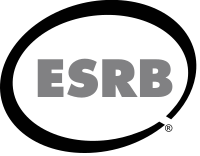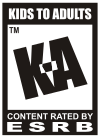Entertainment Software Rating Board
From Sega Retro
The Entertainment Software Rating Board (ESRB) is a self-regulatory organization that puts ratings into force, advertising guidelines, and online privacy principles for computer and video games and other entertainment software in North America.
The ESRB was established in 1994 by the Entertainment Software Association (formerly Interactive Digital Software Association). In early 2003, it had rated over 8,000 titles that had been submitted by 350 publishers.
One of the reasons the ESRB was founded was due to violent content found in video games such as Mortal Kombat and Doom, as well as other controversial video games portraying overly violent or intense sexual situations at the time.
Contents
Overview Of ESRB
The ESRB applies ratings to games based on their content, similar to the motion picture rating systems used in many countries. Their aim is to aid consumers in determining a game's content and suitability. A game's rating is displayed on its box, the media, in advertisements and on game web site(s).
The rating system is voluntary.
Ratings
The symbols the ESRB uses are stylized depictions of alphabetical letters meant to convey at a glance a game's suitability. ESRB uses 7 different ratings. They are:
Current
| Rating | Description |
|---|---|
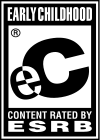
|
EC (Early Childhood): Contains content that is considered suitable for children 3 years of age and older. Games with this rating contain no material that parents or educators would find inappropriate. Games that fall under this rating are specifically intended for young children and are usually educational in nature. Examples of these games are games based on childhood TV shows. |
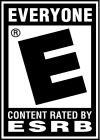
|
E (Everyone): Contains content that is considered unsuitable for children under 6 years of age. Titles in this category may contain minimal cartoon, fantasy or mild violence and/or infrequent use of mild language. Examples of Everyone games include Sonic Adventure, The Legend of Zelda: The Wind Waker, Super Mario Sunshine, Lego Star Wars: The Video Game and New Super Mario Bros. |
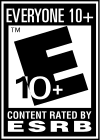
|
E10+ (Everyone ten and older): Contains content that is considered unsuitable for children under 10 years of age. Titles in this category may contain more cartoon, fantasy or mild violence, mild language, animated blood and/or minimal suggestive themes. The ESRB introduced the E10+ rating on March 2, 2005, with Donkey Kong Jungle Beat being the first game to receive this rating. Examples of E10+ games include Madagascar, Lego Star Wars, Meet the Robinsons, Kingdom Hearts II, TMNT, Sonic Unleashed, and Spore. |
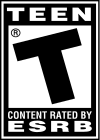
|
T (Teen): Contains content that is considered unsuitable for children under 13 years of age. Titles in this category may contain violence, suggestive themes, crude humor, minimal blood, simulated gambling, and/or infrequent use of moderate to strong language. This rating was often given to games which would have been rated E10+ had they not been released at a time when the E10+ rating did not exist, such as Super Smash Bros. Melee. Examples of Teen games include WWE SmackDown vs. Raw 2009, The Sims series, Soulcalibur IV, Mirror's Edge, The World Ends With You, two games of the Need for Speed series (Most Wanted, Undercover), and Impossible Creatures. This is the highest unrestricted rating. |

|
M (Mature): Contains content that is considered suitable and people the age of 17 and above. Titles in this category may contain intense violence (more so than in the Teen category), blood and gore, sexual themes/content, and frequent use of strong language. Examples of Mature games includes Halo: Combat Evolved, Resident Evil, Tom Clancy's Rainbow Six: Vegas, Resistance: Fall of Man, Call of Duty 4: Modern Warfare, Gears of War, Hitman: Contracts, No More Heroes, Mortal Kombat: Deception, and various others, including all three games in the Doom series (that includes Doom 2, Final Doom, and Doom 3). Many retailers (such as Target and Wal-Mart in the United States, Future Shop in Canada, and Best Buy in both countries) have a policy of not selling games with this rating to teenagers and others under the age of 17 without parental presence and approval. [1] |
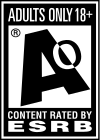
|
AO (Adults Only): Contains content that is not suitable for those under age 18. These may include adult video games that depict sex and nudity and/or extreme depictions of violence that include blood and gore. As of 2009, there have been twenty-five products which have received the rating, most of which are available on Windows and Apple Macintosh computers, as well as the Philips CD-i. The AO rating is the subject of ongoing, heated controversy due to the extreme restrictions it places on game sales. For example, all three of the major video game console manufacturers (Nintendo, Sony and Microsoft) strictly prohibit the release and sale of AO-rated games on their consoles and that means major retailers do not allow AO-rated games on their shelves. Games from major publishers that receive an AO rating are often 'toned down' in order to gain the lesser rating of M such as Grand Theft Auto: San Andreas and Manhunt 2. |
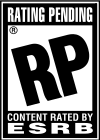
|
RP (Rating Pending): Product has been submitted to the ESRB and is awaiting final rating. This symbol appears only in advertising prior to a game's release. |
Original
The following rating has been updated and is no longer used, but it may appear on games published previously.
Content descriptors
The content descriptors are not exhaustive descriptions of all content within a game: they are applied within the context of the rating a game is assigned. For example, a Teen game with one use of strong language and numerous uses of mild language would receive a "Mild Language" descriptor. They are also not always printed as shown below. They may have additional words added to further clarify the highlighted content such as "Mild Blood" and "Mild Suggestive Themes".
Current
- Alcohol Reference - Reference to and/or images of alcoholic beverages
- Animated Blood - Discolored and/or unrealistic depictions of blood
- Blood - Depictions of blood
- Blood and Gore - Depictions of blood or the mutilation of body parts
- Cartoon Violence - Violent actions involving cartoon-like situations and characters. May include violence where a character is unharmed after the action has been inflicted
- Comic Mischief - Depictions or dialogue involving slapstick or suggestive humor
- Crude Humor - Depictions or dialogue involving vulgar antics, including "bathroom" humor
- Drug Reference - Reference to and/or images of illegal drugs
- Edutainment - Content of product provides user with specific skills development or reinforcement learning within an entertainment setting. Skill development is an integral part of product
- Fantasy Violence - Violent actions of a fantasy nature, involving human or non-human characters in situations easily distinguishable from real life
- Informational - Overall content of product contains data, facts, resource information, reference materials or instructional text
- Intense Violence - Graphic and realistic-looking depictions of physical conflict. May involve extreme and/or realistic blood, gore, weapons, and depictions of human injury and death
- Language - Mild to moderate use of profanity
- Lyrics - Mild references to profanity, sexuality, violence, alcohol, or drug use in music
- Mature Humor - Depictions or dialogue involving "adult" humor, including sexual references
- Nudity - Graphic or prolonged depictions of nudity
- Partial Nudity - Brief and/or mild depictions of nudity
- Real Gambling - Player can gamble, including betting or wagering real cash or currency
- Sexual Content - Non-explicit depictions of sexual behavior, possibly including partial nudity
- Sexual Themes - References to sex or sexuality
- Sexual Violence - Depictions of rape or other sexual acts
- Simulated Gambling - Player can gamble without betting or wagering real cash or currency
- Some Adult Assistance May Be Needed - Intended for very young ages
- Strong Language - Explicit and/or frequent use of profanity
- Strong Lyrics - Explicit and/or frequent references to profanity, sex, violence, alcohol, or drug use in music
- Strong Sexual Content - Explicit and/or frequent depictions of sexual behavior, possibly including nudity
- Suggestive Themes - Mild provocative references or materials
- Tobacco Reference - Reference to and/or images of tobacco products
- Use of Drugs - The consumption or use of illegal drugs
- Use of Alcohol - The consumption of alcoholic beverages
- Use of Tobacco - The consumption of tobacco products
- Violence - Scenes involving aggressive content. May include bloodless dismemberment
- Violent References References to violent acts.
Online Rating Notice
Online games that include user-generated content (e.g., chat, maps, skins) carry the notice Online Interactions Not Rated by the ESRB (formerly Game experience may change during online play) to warn consumers that content created by players of the game has not been rated by the ESRB. This is used to describe the fact that players online may speak in an inappropriate manner, or use profanity (which cannot be effectively rated by ESRB), as well as to warn about possible mods which may not be given a rating by the ESRB.
Original
The following content descriptors have been updated and are no longer used, but they may appear on games published prior to their discontinuation. Reissued games that were originally rated when the now-discontinued descriptors were used by the ESRB may still contain such descriptors on their packaging.
- Animated Blood and Gore — Cartoon or pixelated images of blood or the mutilation of body parts.
- Animated Violence — Cartoon or pixelated scenes depicting animated characters in unsafe and/or violent situations.
- Gambling — Betting-like behavior.
- Gaming — Betting-like behavior.
- Mild Animated Violence — Mild cartoon or pixelated scenes depicting animated characters in unsafe and/or violent situations.
- Mild Realistic Violence — Mild photographic-like detailed depictions of characters in unsafe and/or violent situations.
- Reading Skills, Fine Motor Skills, Higher-Level Thinking Skills — These phrases are found only on products rated Early Childhood and indicate whether children's reading, computer, or other skills are used in these titles.
- Realistic Blood — Photographic-like detailed depictions of blood.
- Realistic Blood and Gore — Photographic-like detailed depictions of blood or the mutilation of body parts.
- Realistic Violence — Highly detailed depictions of characters in unsafe and/or violent situations.
Rating process
To obtain a rating for a game, a publisher sends the ESRB videotaped footage of the most graphic and extreme content found in the game. The publisher also fills out a questionnaire describing the game's content and pays a fee based on the game's development cost:
- $800 fee for development costs under USD $250k
- $4,000 fee for development costs over $250k
On its website, the ESRB states that three trained raters, working independently, watch the footage and recommend a rating. If all raters agree on the rating, content descriptors are added and the ESRB notifies the publisher of its decision. If there is no consensus, additional raters review the footage and materials, or the majority opinion rules. After the rating is agreed upon, the ESRB in-house personnel review the footage and all materials to ensure that all information is accurate and a certificate is sent to the publisher. However, that decision is not final. If the publisher wishes, they may edit the game and resubmit the footage and questionnaire in order to achieve a lower rating, or appeal the information. If this is the case, the process begins anew. The publisher may also appeal the game's rating if they wish. The appeals committee is composed of entertainment software industry representatives.
When the game is ready for release, the publisher sends copies of the final version of the game to the ESRB. The game packaging is reviewed, and the ESRB says that its in-house personnel randomly play games to ensure that all the information provided during the rating process was complete and accurate. Penalties may apply to the publisher if it is eventually found, either through the in-house personnel's playing or consumer comments that the game's content is more extreme than the publisher stated in its application.
The identities of the ESRB raters are kept confidential and selected randomly from a pool of full-time ESRB employees who live in the New York City area. According to an ESRB introductory brochure from 1994: "The raters represent a wide range of backgrounds, races, and ages and have no ties to the interactive entertainment industry. Raters include retired school principals, parents, professionals, and other individuals from all walks of life." In essence allowing people who aren't regular video game players, to review games as if they were the customer and receiving their first glance at the game. They are then required to take testing before becoming ESRB raters.
Background and history
As videogaming progressed into the 16-bit era, graphics and sound capabilities were dramatically increased. Blood and gore was much clearer and vibrant than 8-bit games. For example blood in an 8-bit game may look blocky and pixelated while in 16-bit it can be a fluid graphic that can easily be identified. After the release of games such as Mortal Kombat, Doom, Night Trap and Lethal Enforcers, there was much controversy over video game content. Congressional hearings on video game violence and the corruption of society, headed by Joe Lieberman and Herb Kohl were held in late 1992 to 1993. The result of the hearings was that the entertainment software industry was given one year to form a workable rating system or the federal government would intervene and create its own system. Around this time, the Videogame Rating Council (VRC) was formed by Sega of America to rate mostly its own games. In 1993, the Interactive Digital Software Association (IDSA) was formed. Also in 1993, the 3DO Company formed their own rating system for games released on the 3DO Interactive Multiplayer called the 3DO Rating System. In 1994, the Recreational Software Advisory Council (RSAC) was formed by the Software Publishers Association. However, because of some criticisms of the both the VRC and the 3DO Rating System were phased out in 1994 and RSAC in 1999. On July 29, 1994 the proposal from the IDSA for a rating system, the Entertainment Software Rating Board (ESRB) was presented in Congress and approved. In September 1994, the ESRB was established and became the official rater of video games in the United States. At this time, many companies who produced computer games such as LucasArts, Sierra On-Line and 3D Realms continued to follow the RSAC system as they were members of the SPA. Eventually, all companies, including 3DO, agreed to follow the ESRB ratings.
Initially, there were five different ratings: Early Childhood, Kids to Adults, Teen, Mature and Adults Only. Shortly thereafter, the Informational and Edutainment descriptors were added. In 1996, the rating icons were altered so that it would be more clear who rated the product (this can be seen in the image of the Mature icon above). On January 1, 1998, the Kids to Adults rating was replaced with Everyone. Also in 1998, the Entertainment Software Rating Board Interactive (ESRBi) was formed which rated websites and online games. In late 1999, in order to make the rating symbols more legible, the pixelated rating icons were replaced with black and white icons. Beginning in early 2001, and continuing for the next couple of years, several of the content descriptors were retired and replaced. Content descriptors with "Animated" or "Realistic" in them had those portions removed. Also, the "Skills" descriptors used for the Early Childhood rating were removed as well. A short time later, the Gaming descriptor was changed to Gambling, which itself was split into Real and Simulated Gambling in the following years.
In mid 2003, the ESRBi was closed down. On June 26, 2003, the content descriptors were made larger and more legible and newer, more thorough descriptors for violence (Cartoon, Fantasy, Intense) were added as well as a descriptor for Mature Humor. Also, the Mature and Adults Only icons had a 17+ and 18+ added to their title band in order to clearly signify the age appropriateness. On March 2, 2005, after conferring with academicians and child development experts; the Everyone 10+ rating was introduced. Originally, raters were hired on a part-time basis; as of April 2007, the ESRB employs raters full-time.
See also
- Australia - Office of Film and Literature Classification
- Brazil - Department of Justice, Rating, Titles and Qualification
- Europe (excluding Germany) - Pan European Game Information
- Germany - Voluntary Monitoring Organisation of Entertainment Software
- Japan - Computer Entertainment Rating Organization
- Korea - Game Rating Board
- United Kingdom - British Board of Film Classification
